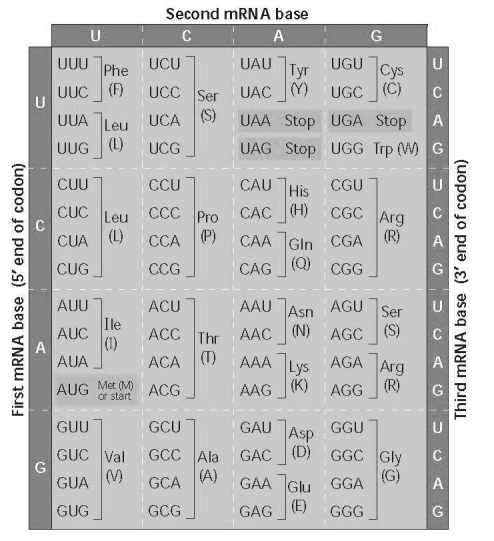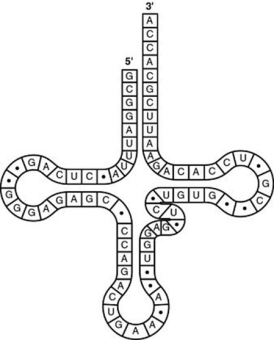A) 1
B) 2
C) 3
D) It cannot be determined from the pathway.
Correct Answer

verified
Correct Answer
verified
Multiple Choice
Which one of the following statements about RNA processing is correct?
A) Exons are cut out before mRNA leaves the nucleus.
B) Ribozymes may function in RNA splicing.
C) RNA splicing can be catalyzed by tRNA.
D) A primary transcript is often much shorter than the final RNA molecule that leaves the nucleus.
Correct Answer

verified
Correct Answer
verified
Multiple Choice
In eukaryotic cells, transcription cannot begin until
A) the two DNA strands have completely separated and exposed the promoter.
B) several transcription factors have bound to the promoter.
C) the 5 caps are removed from the mRNA.
D) the DNA introns are removed from the template.
Correct Answer

verified
Correct Answer
verified
Multiple Choice
Which of the following statements best describes the significance of the TATA box in the promoters of eukaryotes?
A) It is the recognition site for the binding of a specific transcription factor.
B) It sets the reading frame of the mRNA during translation.
C) It is the recognition site for ribosomal binding during translation.
D) It is the recognition site for ribosomal binding during transcription.
Correct Answer

verified
Correct Answer
verified
Multiple Choice
Which of the following statements correctly describes the effect a nonsense mutation would have on a gene?
A) It changes an amino acid in the encoded protein.
B) It has no effect on the amino acid sequence of the encoded protein.
C) It introduces a premature stop codon into the mRNA.
D) It alters the reading frame of the mRNA.
Correct Answer

verified
Correct Answer
verified
Multiple Choice
According to the central dogma, what is the intermediate molecule involved in the flow of information in a cell that should go in the blank? DNA → ________ → Proteins
A) mtDNA
B) rRNA
C) mRNA
D) tRNA
Correct Answer

verified
Correct Answer
verified
Multiple Choice
Codons are three-base sequences in mRNA that specify the addition of a single amino acid to the growing protein chain during translation. How do eukaryotic codons and prokaryotic codons compare?
A) Prokaryotic codons usually contain different bases than those of eukaryotes.
B) Prokaryotic codons usually specify different amino acids than those of eukaryotes.
C) The translation of codons is mediated by tRNAs in eukaryotes, but translation requires no intermediate molecules such as tRNAs in prokaryotes.
D) Codons are a nearly universal language among all organisms.
Correct Answer

verified
Correct Answer
verified
Multiple Choice
Which of the following types of mutation, resulting in an error in the mRNA just after the AUG start of translation, is likely to have the most serious effect on the polypeptide product?
A) a deletion of a codon
B) a deletion of two nucleotides
C) a substitution of the third nucleotide in an ACC codon
D) a substitution of the first nucleotide of a GGG codon
Correct Answer

verified
Correct Answer
verified
Multiple Choice
The following question refers to this table of codons.
 Refer to the figure. Which of the triplets below is a possible anticodon for a tRNA that transports proline to a ribosome?
Refer to the figure. Which of the triplets below is a possible anticodon for a tRNA that transports proline to a ribosome?
A) 3′-UUC-5′
B) 3′-CCG-5′
C) 3′-GGC-5′
D) 3′-CCC-5′
Correct Answer

verified
Correct Answer
verified
Multiple Choice
Which of the following DNA mutations is most likely to damage the protein it specifies?
A) a base-pair deletion
B) an addition of three nucleotides
C) a substitution in the last base of a codon
D) a codon deletion
Correct Answer

verified
Correct Answer
verified
Multiple Choice
Which of the following statements is the most current description of a gene?
A) a unit of heredity that causes formation of a phenotypic characteristic
B) a DNA subunit that codes for a single complete protein
C) a DNA sequence that is expressed to form a functional product: either RNA or polypeptide
D) a discrete unit of hereditary information that consists of a sequence of amino acids
Correct Answer

verified
Correct Answer
verified
Multiple Choice
The genetic code is redundant. What is meant by this statement?
A) A single codon can specify the addition of more than one amino acid.
B) The genetic code is different for different domains of organisms.
C) The genetic code is universal (the same for all organisms) .
D) More than one codon can specify the addition of the same amino acid.
Correct Answer

verified
Correct Answer
verified
Multiple Choice
What would be the consequence of a mutation in a bacterial cell that produces a defective aminoacyl-tRNA synthetase that attaches a lysine instead of the normal phenylalanine to tRNAs with the anticodon AAA?
A) None of the proteins in the cell will contain phenylalanine.
B) Proteins in the cell will include lysine instead of phenylalanine at amino acid positions specified by the codon UUU.
C) The cell will compensate for the defect by attaching phenylalanine to tRNAs with lysine-specifying anticodons.
D) The ribosome will skip a codon every time a UUU is encountered.
Correct Answer

verified
Correct Answer
verified
Multiple Choice
 Using Figure 17.6, identify a 5′ → 3′ sequence of nucleotides in the DNA template strand for an mRNA coding for the polypeptide sequence Phe-Pro-Lys.
Using Figure 17.6, identify a 5′ → 3′ sequence of nucleotides in the DNA template strand for an mRNA coding for the polypeptide sequence Phe-Pro-Lys.
A) 5-UUUCCCAAA-3
B) 5-GAACCCCTT-3
C) 5-CTTCGGGAA-3
D) 5-AAACCCUUU-3
Correct Answer

verified
Correct Answer
verified
Multiple Choice
Which one of the following structures, if missing, would usually prevent translation from starting?
A) exon
B) 5′ cap
C) AUG codon
D) poly-A tail
Correct Answer

verified
Correct Answer
verified
Multiple Choice
Use the figure to answer the question.
 The tRNA shown in the figure has its 3′ end projecting beyond its 5′ end. Which of the following processes will occur at this 3′ end?
The tRNA shown in the figure has its 3′ end projecting beyond its 5′ end. Which of the following processes will occur at this 3′ end?
A) The amino acid binds covalently.
B) The excess nucleotides (ACCA) will be cleaved off at the ribosome.
C) The small and large subunits of the ribosome will attach to it.
D) The 5′ cap of the mRNA will become covalently bound.
Correct Answer

verified
Correct Answer
verified
Multiple Choice
Which of the following statements correctly describes the function of a signal peptide?
A) It directs an mRNA molecule into the cisternal space of the ER.
B) It terminates translation of messenger RNA.
C) It helps target a protein to the ER.
D) It signals the initiation of transcription.
Correct Answer

verified
Correct Answer
verified
Multiple Choice
Which of the following characteristics is directly related to the coding of a single amino acid during the process of translation?
A) the base sequence of the tRNA
B) the amino acetyl tRNA synthase
C) the three-base sequence of mRNA
D) the complementarity of DNA and RNA
Correct Answer

verified
Correct Answer
verified
Multiple Choice
Use the following information to answer the question. A part of an mRNA molecule with the following sequence is being read by a ribosome: 5?-CCG-ACG-3? (mRNA) . The following charged transfer RNA molecules (with their anticodons shown in the 3? to 5? direction) are available. Two of them can correctly match the mRNA so that a dipeptide can form. Which of the following dipeptides will form from this mRNA?
A) cysteine-alanine
B) proline-threonine
C) glycine-cysteine
D) alanine-alanine
Correct Answer

verified
Correct Answer
verified
Multiple Choice
Use the figure to answer the question.
 Refer to the metabolic pathway illustrated. If A, B, and C are all required for growth, a strain mutant for the gene encoding enzyme B would be able to grow on medium supplemented with which of the following nutrient(s) ?
Refer to the metabolic pathway illustrated. If A, B, and C are all required for growth, a strain mutant for the gene encoding enzyme B would be able to grow on medium supplemented with which of the following nutrient(s) ?
A) nutrient A only
B) nutrient B only
C) nutrient C only
D) nutrients A and C
Correct Answer

verified
Correct Answer
verified
Showing 21 - 40 of 67
Related Exams